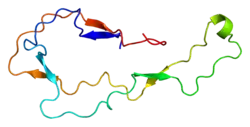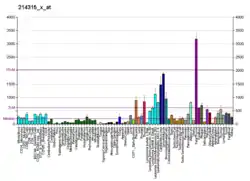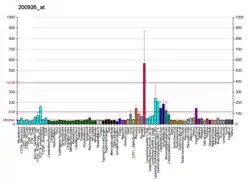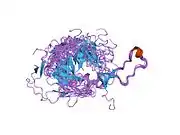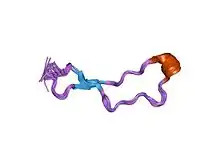Calreticulin
Calreticulin also known as calregulin, CRP55, CaBP3, calsequestrin-like protein, and endoplasmic reticulum resident protein 60 (ERp60) is a protein that in humans is encoded by the CALR gene.[5][6]
Calreticulin is a multifunctional soluble protein that binds Ca2+ ions (a second messenger in signal transduction), rendering it inactive. The Ca2+ is bound with low affinity, but high capacity, and can be released on a signal (see inositol trisphosphate). Calreticulin is located in storage compartments associated with the endoplasmic reticulum and is considered an ER resident protein.[6]
The term "Mobilferrin"[7] is considered to be the same as calreticulin by some sources.[8]
Function
Calreticulin binds to misfolded proteins and prevents them from being exported from the endoplasmic reticulum to the Golgi apparatus.
A similar quality-control molecular chaperone, calnexin, performs the same service for soluble proteins as does calreticulin, however it is a membrane-bound protein. Both proteins, calnexin and calreticulin, have the function of binding to oligosaccharides containing terminal glucose residues, thereby targeting them for degradation. Calreticulin and Calnexin's ability to bind carbohydrates associates them with the lectin protein family. In normal cellular function, trimming of glucose residues off the core oligosaccharide added during N-linked glycosylation is a part of protein processing. If "overseer" enzymes note that residues are misfolded, proteins within the rER will re-add glucose residues so that other calreticulin/calnexin can bind to these proteins and prevent them from proceeding to the Golgi. This leads these aberrantly folded proteins down a path whereby they are targeted for degradation.
Studies on transgenic mice reveal that calreticulin is a cardiac embryonic gene that is essential during development.[9]
Calreticulin and calnexin are also integral in the production of MHC class I proteins. As newly synthesized MHC class I α-chains enter the endoplasmic reticulum, calnexin binds on to them retaining them in a partly folded state.[10] After the β2-microglobulin binds to the peptide-loading complex (PLC), calreticulin (along with ERp57) takes over the job of chaperoning the MHC class I protein while the tapasin links the complex to the transporter associated with antigen processing (TAP) complex. This association prepares the MHC class I to bind an antigen for presentation on the cell surface.
Transcription regulation
Calreticulin is also found in the nucleus, suggesting that it may have a role in transcription regulation. Calreticulin binds to the synthetic peptide KLGFFKR, which is almost identical to an amino acid sequence in the DNA-binding domain of the superfamily of nuclear receptors. The amino terminus of calreticulin interacts with the DNA-binding domain of the glucocorticoid receptor and prevents the receptor from binding to its specific glucocorticoid response element. Calreticulin can inhibit the binding of androgen receptor to its hormone-responsive DNA element and can inhibit androgen receptor and retinoic acid receptor transcriptional activities in vivo, as well as retinoic acid-induced neuronal differentiation. Thus, calreticulin can act as an important modulator of the regulation of gene transcription by nuclear hormone receptors.
Clinical significance
Calreticulin binds to antibodies in certain area of systemic lupus and Sjögren patients that contain anti-Ro/SSA antibodies. Systemic lupus erythematosus is associated with increased autoantibody titers against calreticulin, but calreticulin is not a Ro/SS-A antigen. Earlier papers referred to calreticulin as an Ro/SS-A antigen, but this was later disproven. Increased autoantibody titer against human calreticulin is found in infants with complete congenital heart block of both the IgG and IgM classes.[11]
In 2013, two groups detected calreticulin mutations in a majority of JAK2-negative/MPL-negative patients with essential thrombocythemia and primary myelofibrosis, which makes CALR mutations the second most common in myeloproliferative neoplasms. All mutations (insertions or deletions) affected the last exon, generating a reading frame shift of the resulting protein, that creates a novel terminal peptide and causes a loss of endoplasmic reticulum KDEL retention signal.[12][13]
Role in cancer
Calreticulin (CRT) is expressed in many cancer cells and plays a role to promote macrophages to engulf hazardous cancerous cells. The reason why most of the cells are not destroyed is the presence of another molecule with signal CD47, which blocks CRT. Hence antibodies that block CD47 might be useful as a cancer treatment. In mice models of myeloid leukemia and non-Hodgkin lymphoma, anti-CD47 were effective in clearing cancer cells while normal cells were unaffected.[14]
Interactions
Calreticulin has been shown to interact with Perforin[15] and NK2 homeobox 1.[16]
References
- GRCh38: Ensembl release 89: ENSG00000179218 - Ensembl, May 2017
- GRCm38: Ensembl release 89: ENSMUSG00000003814 - Ensembl, May 2017
- "Human PubMed Reference:". National Center for Biotechnology Information, U.S. National Library of Medicine.
- "Mouse PubMed Reference:". National Center for Biotechnology Information, U.S. National Library of Medicine.
- McCauliffe DP, Zappi E, Lieu TS, Michalak M, Sontheimer RD, Capra JD (Jul 1990). "A human Ro/SS-A autoantigen is the homologue of calreticulin and is highly homologous with onchocercal RAL-1 antigen and an aplysia "memory molecule"". The Journal of Clinical Investigation. 86 (1): 332–5. doi:10.1172/JCI114704. PMC 296725. PMID 2365822.
- "Entrez Gene: calreticulin".
- Mobilferrin at the U.S. National Library of Medicine Medical Subject Headings (MeSH)
- Beutler E, West C, Gelbart T (June 1997). "HLA-H and associated proteins in patients with hemochromatosis". Molecular Medicine. 3 (6): 397–402. doi:10.1007/BF03401686. PMC 2230203. PMID 9234244.
- Michalak M, Lynch J, Groenendyk J, Guo L, Robert Parker JM, Opas M (Nov 2002). "Calreticulin in cardiac development and pathology". Biochimica et Biophysica Acta (BBA) - Proteins and Proteomics. 1600 (1–2): 32–7. doi:10.1016/S1570-9639(02)00441-7. PMID 12445456.
- Murphy K (2011). Janeway's Immunobiology (8th ed.). Oxford: Taylor & Francis. ISBN 978-0815342434.
- "Entrez Gene: CALR calreticulin".
- Nangalia J, Massie CE, Baxter EJ, Nice FL, Gundem G, Wedge DC, Avezov E, Li J, Kollmann K, Kent DG, Aziz A, Godfrey AL, Hinton J, Martincorena I, Van Loo P, Jones AV, Guglielmelli P, Tarpey P, Harding HP, Fitzpatrick JD, Goudie CT, Ortmann CA, Loughran SJ, Raine K, Jones DR, Butler AP, Teague JW, O'Meara S, McLaren S, Bianchi M, Silber Y, Dimitropoulou D, Bloxham D, Mudie L, Maddison M, Robinson B, Keohane C, Maclean C, Hill K, Orchard K, Tauro S, Du MQ, Greaves M, Bowen D, Huntly BJ, Harrison CN, Cross NC, Ron D, Vannucchi AM, Papaemmanuil E, Campbell PJ, Green AR (Dec 2013). "Somatic CALR mutations in myeloproliferative neoplasms with nonmutated JAK2". The New England Journal of Medicine. 369 (25): 2391–405. doi:10.1056/NEJMoa1312542. PMC 3966280. PMID 24325359.
- Klampfl T, Gisslinger H, Harutyunyan AS, Nivarthi H, Rumi E, Milosevic JD, Them NC, Berg T, Gisslinger B, Pietra D, Chen D, Vladimer GI, Bagienski K, Milanesi C, Casetti IC, Sant'Antonio E, Ferretti V, Elena C, Schischlik F, Cleary C, Six M, Schalling M, Schönegger A, Bock C, Malcovati L, Pascutto C, Superti-Furga G, Cazzola M, Kralovics R (Dec 2013). "Somatic mutations of calreticulin in myeloproliferative neoplasms". The New England Journal of Medicine. 369 (25): 2379–90. doi:10.1056/NEJMoa1311347. PMID 24325356.
- Chao MP, Jaiswal S, Weissman-Tsukamoto R, Alizadeh AA, Gentles AJ, Volkmer J, Weiskopf K, Willingham SB, Raveh T, Park CY, Majeti R, Weissman IL (Dec 2010). "Calreticulin is the dominant pro-phagocytic signal on multiple human cancers and is counterbalanced by CD47". Science Translational Medicine. 2 (63): 63ra94. doi:10.1126/scitranslmed.3001375. PMC 4126904. PMID 21178137.
- Christopher Vaughan (December 22, 2010). "Many cancer cells found to have an 'eat me' signal in study". Stanford School of Medicine. Archived from the original on 2013-10-16.
- Andrin C, Pinkoski MJ, Burns K, Atkinson EA, Krahenbuhl O, Hudig D, Fraser SA, Winkler U, Tschopp J, Opas M, Bleackley RC, Michalak M (Jul 1998). "Interaction between a Ca2+-binding protein calreticulin and perforin, a component of the cytotoxic T-cell granules". Biochemistry. 37 (29): 10386–94. doi:10.1021/bi980595z. PMID 9671507.
- Perrone L, Tell G, Di Lauro R (Feb 1999). "Calreticulin enhances the transcriptional activity of thyroid transcription factor-1 by binding to its homeodomain". The Journal of Biological Chemistry. 274 (8): 4640–5. doi:10.1074/jbc.274.8.4640. PMID 9988700.
Further reading
- Del Bem LE (Feb 2011). "The evolutionary history of calreticulin and calnexin genes in green plants". Genetica. 139 (2): 225–9. doi:10.1007/s10709-010-9544-y. PMID 21222018. S2CID 9228786.
- Coppolino MG, Dedhar S (May 1998). "Calreticulin". The International Journal of Biochemistry & Cell Biology. 30 (5): 553–8. doi:10.1016/S1357-2725(97)00153-2. PMID 9693955.
- Brucato A, Grava C, Bortolati M, Ikeda K, Milanesi O, Cimaz R, Ramoni V, Vignati G, Martinelli S, Sadou Y, Borghi A, Tincani A, Chan EK, Ruffatti A (Aug 2009). "Congenital heart block not associated with anti-Ro/La antibodies: comparison with anti-Ro/La-positive cases". The Journal of Rheumatology. 36 (8): 1744–8. doi:10.3899/jrheum.080737. PMC 2798588. PMID 19567621.
- Peng RQ, Chen YB, Ding Y, Zhang R, Zhang X, Yu XJ, Zhou ZW, Zeng YX, Zhang XS (May 2010). "Expression of calreticulin is associated with infiltration of T-cells in stage IIIB colon cancer". World Journal of Gastroenterology. 16 (19): 2428–34. doi:10.3748/wjg.v16.i19.2428. PMC 2874150. PMID 20480531.
- Tarr JM, Young PJ, Morse R, Shaw DJ, Haigh R, Petrov PG, Johnson SJ, Winyard PG, Eggleton P (Sep 2010). "A mechanism of release of calreticulin from cells during apoptosis". Journal of Molecular Biology. 401 (5): 799–812. doi:10.1016/j.jmb.2010.06.064. hdl:10871/20264. PMID 20624402.
- Abd Alla J, Reeck K, Langer A, Streichert T, Quitterer U (Sep 2009). "Calreticulin enhances B2 bradykinin receptor maturation and heterodimerization" (PDF). Biochemical and Biophysical Research Communications. 387 (1): 186–90. doi:10.1016/j.bbrc.2009.07.011. PMID 19580784.
- Caramelo JJ, Parodi AJ (Apr 2008). "Getting in and out from calnexin/calreticulin cycles". The Journal of Biological Chemistry. 283 (16): 10221–5. doi:10.1074/jbc.R700048200. PMC 2447651. PMID 18303019.
- Du XL, Yang H, Liu SG, Luo ML, Hao JJ, Zhang Y, Lin DC, Xu X, Cai Y, Zhan QM, Wang MR (Oct 2009). "Calreticulin promotes cell motility and enhances resistance to anoikis through STAT3-CTTN-Akt pathway in esophageal squamous cell carcinoma". Oncogene. 28 (42): 3714–22. doi:10.1038/onc.2009.237. PMID 19684620.
- Gelebart P, Opas M, Michalak M (Feb 2005). "Calreticulin, a Ca2+-binding chaperone of the endoplasmic reticulum". The International Journal of Biochemistry & Cell Biology. 37 (2): 260–6. doi:10.1016/j.biocel.2004.02.030. PMID 15474971.
- Qiu Y, Michalak M (Mar 2009). "Transcriptional control of the calreticulin gene in health and disease". The International Journal of Biochemistry & Cell Biology. 41 (3): 531–8. doi:10.1016/j.biocel.2008.06.020. PMID 18765291.
- Zhu Y, Zhang W, Veerapen N, Besra G, Cresswell P (Dec 2010). "Calreticulin controls the rate of assembly of CD1d molecules in the endoplasmic reticulum". The Journal of Biological Chemistry. 285 (49): 38283–92. doi:10.1074/jbc.M110.170530. PMC 2992262. PMID 20861015.
- Talmud PJ, Drenos F, Shah S, Shah T, Palmen J, Verzilli C, Gaunt TR, Pallas J, Lovering R, Li K, Casas JP, Sofat R, Kumari M, Rodriguez S, Johnson T, Newhouse SJ, Dominiczak A, Samani NJ, Caulfield M, Sever P, Stanton A, Shields DC, Padmanabhan S, Melander O, Hastie C, Delles C, Ebrahim S, Marmot MG, Smith GD, Lawlor DA, Munroe PB, Day IN, Kivimaki M, Whittaker J, Humphries SE, Hingorani AD (Nov 2009). "Gene-centric association signals for lipids and apolipoproteins identified via the HumanCVD BeadChip". American Journal of Human Genetics. 85 (5): 628–42. doi:10.1016/j.ajhg.2009.10.014. PMC 2775832. PMID 19913121.
- Taner SB, Pando MJ, Roberts A, Schellekens J, Marsh SG, Malmberg KJ, Parham P, Brodsky FM (Jan 2011). "Interactions of NK cell receptor KIR3DL1*004 with chaperones and conformation-specific antibody reveal a functional folded state as well as predominant intracellular retention". Journal of Immunology. 186 (1): 62–72. doi:10.4049/jimmunol.0903657. PMC 3129036. PMID 21115737.
- Tarr JM, Winyard PG, Ryan B, Harries LW, Haigh R, Viner N, Eggleton P (Oct 2010). "Extracellular calreticulin is present in the joints of patients with rheumatoid arthritis and inhibits FasL (CD95L)-mediated apoptosis of T cells" (PDF). Arthritis and Rheumatism. 62 (10): 2919–29. doi:10.1002/art.27602. hdl:10871/13850. PMID 20533543.
- Kepp O, Gdoura A, Martins I, Panaretakis T, Schlemmer F, Tesniere A, Fimia GM, Ciccosanti F, Burgevin A, Piacentini M, Eggleton P, Young PJ, Zitvogel L, van Endert P, Kroemer G (Aug 2010). "Lysyl tRNA synthetase is required for the translocation of calreticulin to the cell surface in immunogenic death". Cell Cycle. 9 (15): 3072–7. doi:10.4161/cc.9.15.12459. PMID 20699648.
- Sato H, Azuma Y, Higai K, Matsumoto K (Oct 2009). "Altered expression of glycoproteins on the cell surface of Jurkat cells during etoposide-induced apoptosis: shedding and intracellular translocation of glycoproteins". Biochimica et Biophysica Acta (BBA) - General Subjects. 1790 (10): 1198–205. doi:10.1016/j.bbagen.2009.05.019. PMID 19524015.
- Hong C, Qiu X, Li Y, Huang Q, Zhong Z, Zhang Y, Liu X, Sun L, Lv P, Gao XM (Oct 2010). "Functional analysis of recombinant calreticulin fragment 39-272: implications for immunobiological activities of calreticulin in health and disease". Journal of Immunology. 185 (8): 4561–9. doi:10.4049/jimmunol.1000536. PMID 20855873.
- Alur M, Nguyen MM, Eggener SE, Jiang F, Dadras SS, Stern J, Kimm S, Roehl K, Kozlowski J, Pins M, Michalak M, Dhir R, Wang Z (Aug 2009). "Suppressive roles of calreticulin in prostate cancer growth and metastasis". The American Journal of Pathology. 175 (2): 882–90. doi:10.2353/ajpath.2009.080417. PMC 2716982. PMID 19608864.
- Bailey SD, Xie C, Do R, Montpetit A, Diaz R, Mohan V, Keavney B, Yusuf S, Gerstein HC, Engert JC, Anand S (Oct 2010). "Variation at the NFATC2 locus increases the risk of thiazolidinedione-induced edema in the Diabetes REduction Assessment with ramipril and rosiglitazone Medication (DREAM) study". Diabetes Care. 33 (10): 2250–3. doi:10.2337/dc10-0452. PMC 2945168. PMID 20628086.
- Nabi MO, Mirabzadeh A, Feizzadeh G, Khorshid HR, Karimlou M, Yeganeh MZ, Asgharian AM, Najmabadi H, Ohadi M (Mar 2010). "Novel mutations in the calreticulin gene core promoter and coding sequence in schizoaffective disorder". American Journal of Medical Genetics Part B. 153B (2): 706–9. doi:10.1002/ajmg.b.31036. PMID 19760677. S2CID 6959934.
- Schardt JA, Eyholzer M, Timchenko NA, Mueller BU, Pabst T (Jun 2010). "Unfolded protein response suppresses CEBPA by induction of calreticulin in acute myeloid leukaemia". Journal of Cellular and Molecular Medicine. 14 (6B): 1509–19. doi:10.1111/j.1582-4934.2009.00870.x. PMC 3829017. PMID 19659458.
External links
- Calreticulin at the U.S. National Library of Medicine Medical Subject Headings (MeSH)
